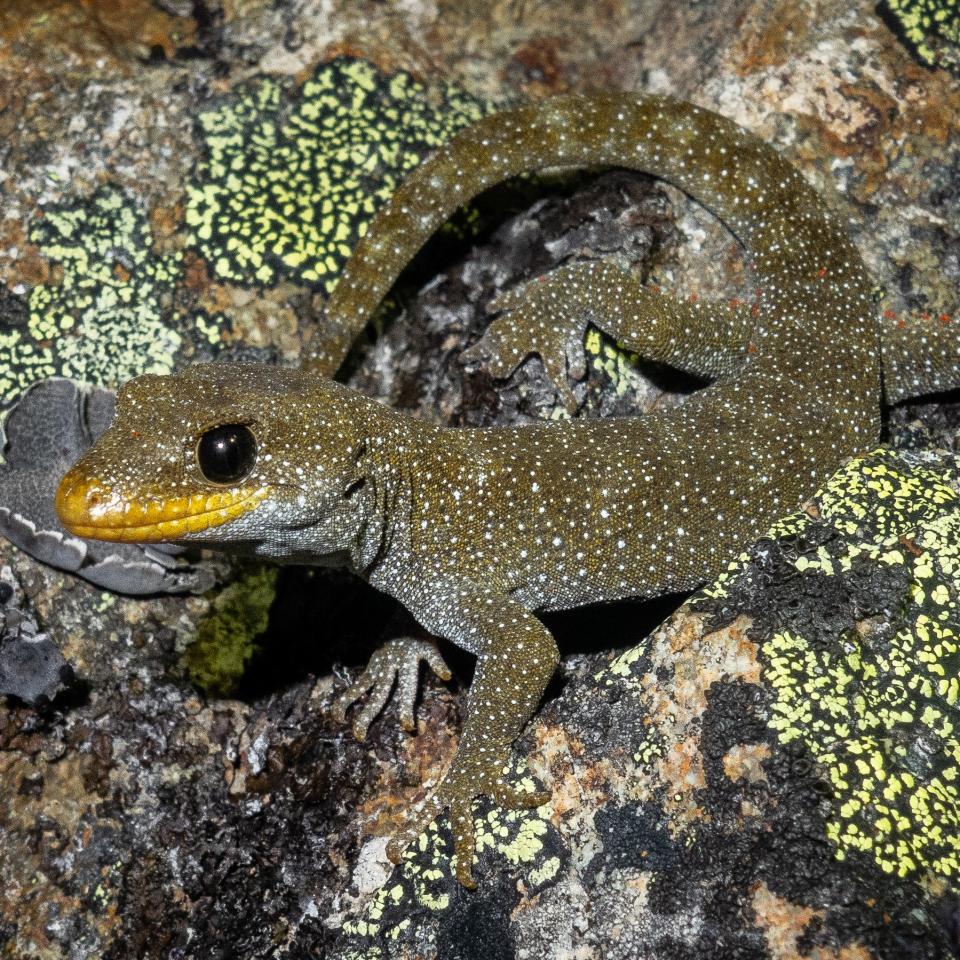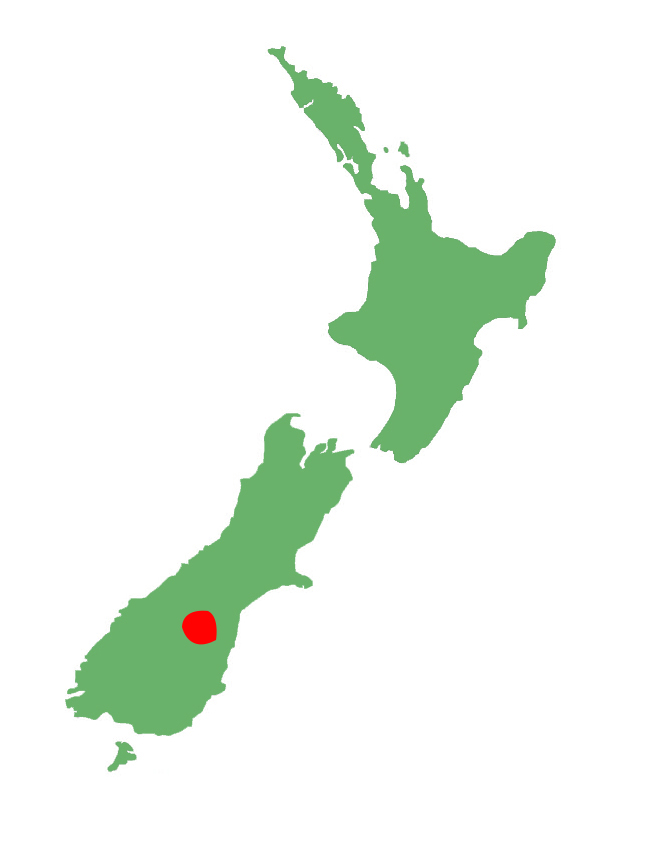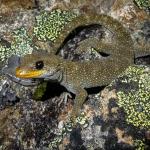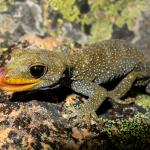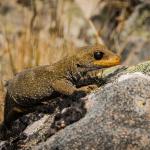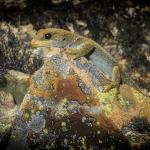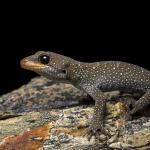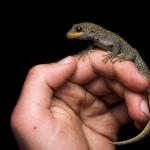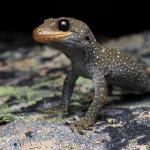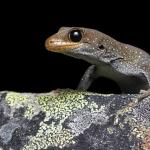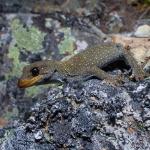- Home
- Herpetofauna Index
- Native
- Mokopirirakau Galaxias
Mokopirirakau galaxias
Hura te ao gecko
Mokopirirakau galaxias
(Knox, et al., 2021)
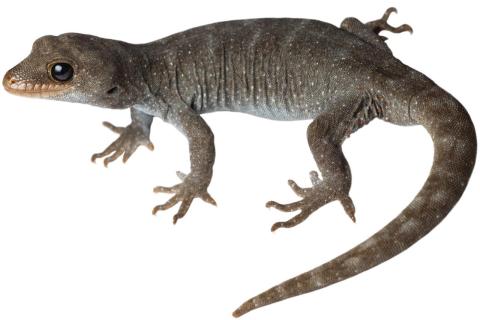
Length: SVL At least up to 88 mm SVL
Weight: At least up to 9.7g
Description
The Hura te ao gecko was discovered in 2018 in alpine greywacke rock outcrops in the Oteake Conservation Park, North Otago. Although somewhat similar to the black-eyed gecko (M. kahutarae), hura te ao geckos have a distinctive galaxy-like patterning of small white spots on the dorsal and lateral surfaces of the body and several other differences as described below. Genetic analyses using the mitochondrial ND2 gene indicate that hura te ao gecko is likely to be sister to a group containing both M. granulatus and M. kahutarae. Species status is justified by its apparent phylogenetic position as sister species to M. kahutarae plus M. granulatus, and multiple diagnostic morphological differences (Knox et al. 2021). It is characterised from all but one Mokopirirakau species by colour pattern alone, and from M. kahutarae by smaller adult body size, eye and eyebrow characters, mouth and throat colour, ventral scale row count, tail length, toe shape, and lamellar count (Knox et al. 2021). The type locality of hura te ao gecko is ~400 kilometres south of the nearest M. kahutarae populations in the upper South Island, although it is possible that either the hura te ao gecko or M. kahutarae may occur elsewhere in the South Island mountain ranges (Knox et al. 2021). Several new sites were found for hura te ao gecko in spring / summer 2020-21 and it is now known from six sites across two mountain ranges within Oteake Conservation Park (pers.comm Carey Knox).
Life expectancy
Unknown, but likely to be long-lived. Growth and reproductive rates likely to be low given extremely cold alpine habitat (pers.comm Carey Knox).
Distribution
Known from six sites across two mountain ranges within the 65,000-hectare Oteake Conservation Park. Thought to be an alpine specialist. Potential habitat for this species is present in several mountain ranges, particularly the Ida Range, Hawkdun Range, St Marys Range, Saint Bathans Range, and other mountain ranges with tor and boulderfield habitat in North Otago and the Mackenzie Country. Both M. kahutarae and hura te ao gecko are thought to be solely alpine in nature, however distributional limits and pre-human altitudinal limits of both are unknown. The ~400-kilometre distributional gap between them may at least partly be an artefact of poor sampling, particularly given the difficult access to many of their habitats. Suitably creviced rock exposures occur widely in the mountain ranges between their known distributions but are patchy in distribution (pers.comm Carey Knox).
Ecology and habitat
Fractured and deeply creviced greywacke outcrops, tors, bluffs, boulderfield, and talus slopes. Snow tussock (Chionochloa rigida) grassland is the predominant vegetation in the area, interrupted in places by greywacke rock outcrops, or varying amounts of rock talus, fellfield and/or scree (Knox et al. 2021).
Social structure
Unknown. Individuals appear to be solitary and aggregations of individuals have not been seen. There have been about 27 individuals sighted thus far, including a mixture of (mostly) adults, sub-adults, and three juveniles (pers.comm Carey Knox).
Breeding biology
Unknown, but unlikely to give birth annually given the high-altitude of known populations (pers.comm Carey Knox).
Diet
Unknown. Likely to be mostly insectivorous feeding on moths, spiders, weta, and other invertebrates that it co-exists with in it’s alpine tor or boulderfield habitat (pers.comm Carey Knox).
Disease
Unknown.
Conservation strategy
Should be considered “Threatened – Nationally Endangered” (qualifiers Data Poor) in the New Zealand Threat Classification System due to the low abundance and restricted known distribution, with potential threats from invasive predatory mammals, climate change, and poaching. If subsequent survey effort locates more populations, this status can be reassessed (pers.comm Carey Knox).
Interesting notes
The Hura te Ao gecko's common name translates to the breaking of the dawn and is a reference to the yellow colour found around its mouth, as well as Hura hinting at the gecko revealing itself to us. The specific name 'galaxias' means galaxy-like and refers to the star-like white dots that cover their dorsal surfaces.
Despite being very similar in appearance to the black-eyed gecko (M. kahutarae), and sitting within the northern clade of the Mokopirirakau genus, the hura te ao gecko is not the black-eyed gecko's closest relative. The black-eyed gecko is more closely related to the forest gecko (M. granulatus), with the hura te ao gecko being more distantly related to both species.

